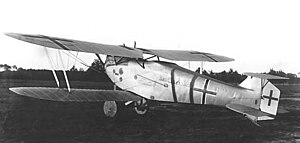Hannover CL.II
| CL.II | |
|---|---|

| |
| Role | Escort fighter |
| National origin | Germany |
| Manufacturer | Hannoversche Waggonfabrik |
| Designer | Hermann Dorner |
| First flight | 1917 |
| Primary user | Luftstreitkräfte |
| Number built | 439 |
The Hannover CL.II was an escort fighter, produced in Germany during World War I, designed in response to a 1917 requirement by the Idflieg for such a machine to protect reconnaissance aircraft over enemy territory.
Design and development
The CL.II was a compact
The main units of the fixed tail skid undercarriage were linked by a cross-axle and the pilot and tail gunner sat in tandem, open cockpits, with the gunner's cockpit elevated above the line of the upper fuselage to afford him a greater
The CL.II was also produced under licence by LFG, under the designation CL.IIa. The type was widely produced, and as the war continued, was increasingly employed as a ground attack machine, remaining in service in this role until the Armistice.
A copy of Hannover CL.II, named CWL SK-1 Słowik, was the first aircraft built in independent Poland, in CWL in Warsaw in 1919. It however crashed during a public flight on August 23, 1919 in Warsaw, due to faulty bracing wires, killing its constructor Karol Słowik.[1]
Specifications
Data from German Aircraft of the First World War [2]
General characteristics
- Crew: 2
- Length: 7.58 m (24 ft 10 in)
- Wingspan: 11.7 m (38 ft 5 in)
- Height: 2.8 m (9 ft 2 in)
- Wing area: 32.7 m2 (352 sq ft)
- Empty weight: 717 kg (1,581 lb)
- Gross weight: 1,081 kg (2,383 lb)
- Powerplant: 1 × Argus As.III6-cylinder water-cooled in-line piston engine, 134 kW (180 hp)
- Propellers: 2-bladed fixed-pitch propeller
Performance
- Maximum speed: 165 km/h (103 mph, 89 kn) at 5,000 m (16,000 ft)
- Endurance: 3 hours 30 minutes
- Service ceiling: 7,500 m (24,600 ft)
- Time to altitude: 5,000 m (16,000 ft) in 5 minutes 18 seconds
Armament
- Guns: :*1 × fixed, forward-firing 7.92 mm LMG 08/15Spandau machine gun
- 1 × trainable, rearward-firing 7.92 mm Parabellum MG14machine gun for observer
- 1 × trainable, rearward-firing 7.92 mm
References
- ^ Morgała, Andrzej. O samolocie inż. Słowika raz jeszcze in: "Lotnictwo z szachownicą" nr. 21(1/2007), pp.30-33 (in Polish)
- ISBN 0-370-00103-6.
Bibliography
- Gray, Peter & Thetford, Owen (1987) [1970]. German Aircraft of the First World War (2nd ed.). London: Putnam. ISBN 0-85177-809-7.
- Rimell, Ray & Woodman, Harry (2015). 'HAWA'! (Vol. 2). Windsock Datafile. Vol. 169. Berkhampstead, UK: Albatros Productions. ISBN 978-1-906798-44-4.
